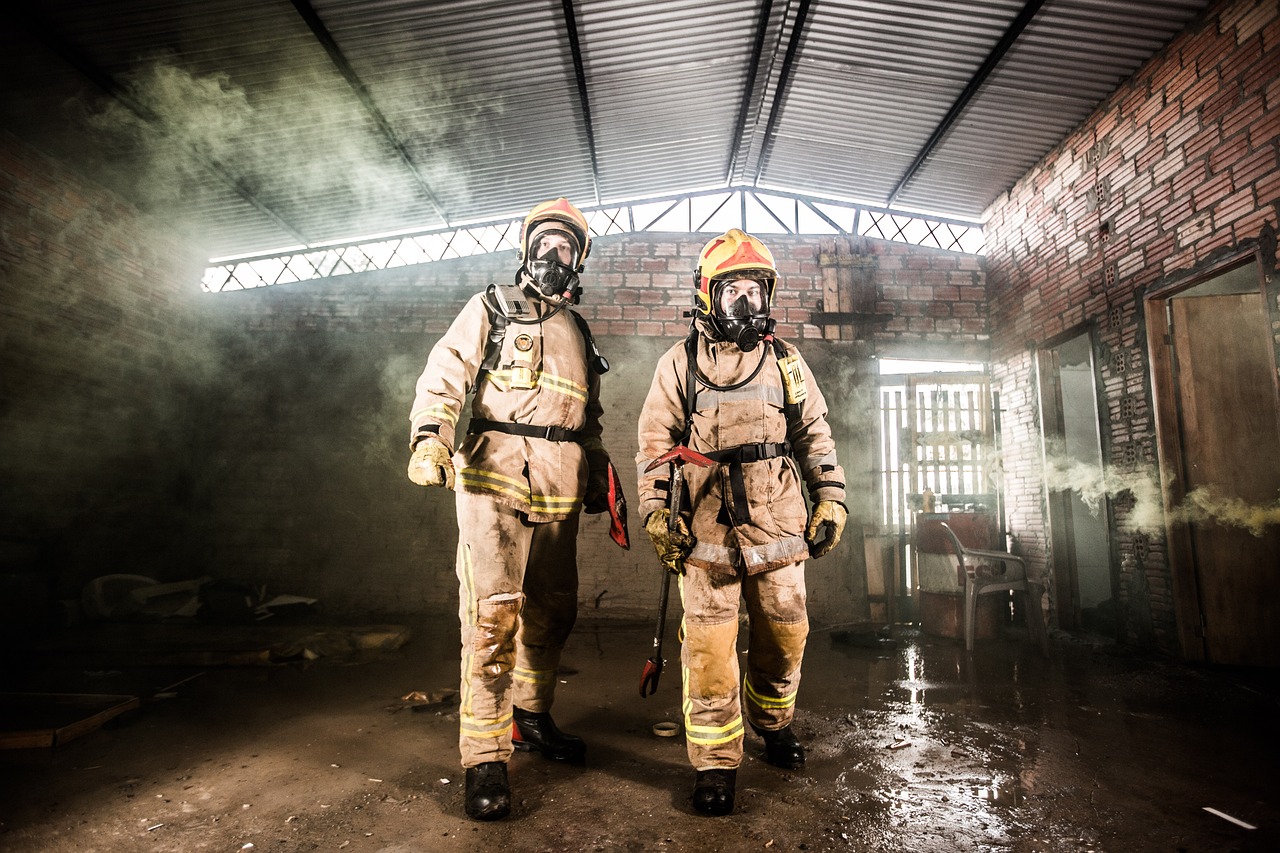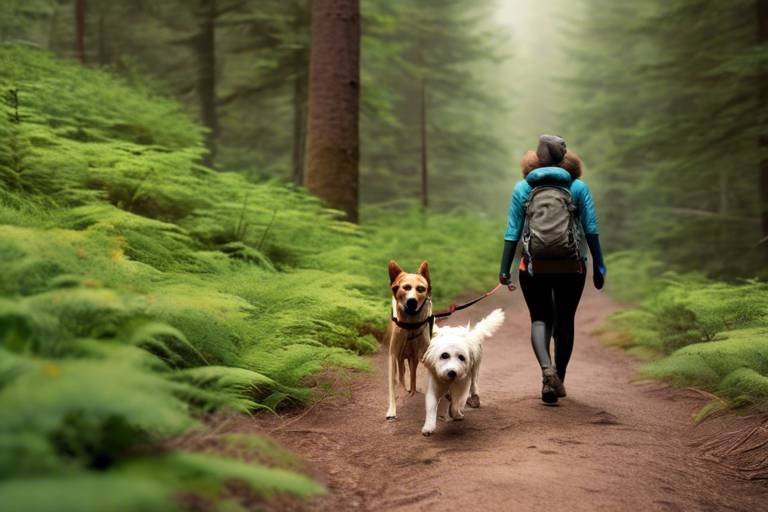Understanding the Benefits of Training for Rescue Dogs
When it comes to rescue dogs, training is not just an option—it's a necessity. Imagine bringing home a furry friend who has faced hardships, uncertainty, and perhaps even trauma. Training offers these dogs a chance to thrive in their new environment, transforming them into well-adjusted companions. The benefits of training are profound and multi-faceted, impacting not only the dogs themselves but also their human families. From improved behavior to enhanced safety, let's dive into the numerous advantages that come with training rescue dogs.
One of the most significant benefits of training is the improvement in behavior. Rescue dogs often come from challenging backgrounds, which can lead to anxiety or aggression. Through consistent training, these dogs learn essential manners and social skills that help them navigate their new homes more effectively. Imagine a dog that used to jump on every visitor now calmly waiting for a greeting. This transformation creates a more harmonious living environment, not just for the dog but for everyone in the household. It fosters a stronger bond between the dog and its owner, as both parties learn to communicate better.
Training also plays a crucial role in enhancing safety. A well-trained dog knows how to respond to commands, which can be vital in preventing dangerous situations. For instance, a recall command can save a dog from running into traffic or getting lost. Picture this: your dog is off-leash at the park, and suddenly a squirrel darts by. With proper training, your dog will respond to your call, avoiding potential chaos. This not only protects the dog but also provides peace of mind for the owner.
Did you know that well-trained dogs are more likely to be adopted? It's true! Increased adoption rates are a direct result of training. Potential adopters are drawn to dogs that display good behavior and social skills. Training showcases a dog's temperament and abilities, making them more appealing. When a rescue organization presents a dog that sits, stays, and interacts positively with people and other dogs, it significantly increases the chances of finding a forever home. This is a win-win situation, as it not only helps the dog but also reduces the number of animals in shelters.
Training is a fantastic way to strengthen the bond between a dog and its owner. Engaging in training activities together fosters trust and understanding. Think of it as a dance—both partners must learn to move in sync. As you teach your dog new commands and tricks, you’re not just imparting knowledge; you’re building a relationship based on mutual respect and love. This deeper emotional connection benefits both the dog and the owner, creating a happier home.
Training classes offer essential socialization opportunities for rescue dogs. These classes allow dogs to interact with other dogs and people, helping them become more comfortable in various environments. It's like sending your dog to school—where they learn not only academics but also how to make friends! This interaction reduces fear and anxiety in new situations, making outings to parks or pet-friendly stores much more enjoyable. A well-socialized dog is a confident dog, ready to take on the world!
Training is not just about correcting behavior; it also provides physical and mental stimulation. Engaging activities keep rescue dogs active and mentally sharp. Imagine a dog that spends hours lying around versus one that participates in fun training sessions. The latter is not only healthier but also happier! Regular training helps to channel a dog’s energy in productive ways, reducing destructive behaviors and promoting overall well-being.
Many rescue dogs come with behavioral issues that need addressing, such as barking, jumping, or chewing. Training can effectively tackle these problems, creating a more peaceful living environment. For example, if a dog tends to bark excessively when strangers approach, training can help modify this behavior. Identifying and correcting unwanted behaviors leads to a more harmonious household, where both the dog and the family can thrive.
Training empowers rescue dogs by building their confidence. As they learn new commands and tricks, they experience a sense of accomplishment that boosts their self-esteem. Imagine a dog that once cowered in the corner now strutting around proudly after mastering a new trick. This newfound confidence helps them feel more secure in their new surroundings, making them more adaptable and resilient to changes.
Investing time in training reflects a long-term commitment to the dog's well-being. It shows the dog that their owner is dedicated to providing a stable and loving home. This dedication fosters trust and loyalty, creating a lasting bond that benefits both parties. Just like any meaningful relationship, the more effort you put in, the more rewarding it becomes.
- What type of training is best for rescue dogs? Positive reinforcement training is often the most effective, as it encourages good behavior through rewards.
- How long should I train my rescue dog each day? Short, consistent sessions of 10-15 minutes are usually ideal, keeping your dog engaged without overwhelming them.
- Can I train an older rescue dog? Absolutely! Dogs of all ages can learn new commands and behaviors with patience and consistency.

Improved Behavior
When it comes to bringing a rescue dog into your home, one of the most significant advantages of training is the improvement in behavior. Imagine a dog that once cowered in fear or barked excessively now becoming a well-mannered companion. Training helps these dogs develop better manners and social skills, which is essential for their integration into family life. By teaching them basic commands like "sit," "stay," and "come," you’re not just instructing them; you’re also providing them with a sense of structure and security.
Consider this: a dog that knows how to behave in various situations is less likely to experience anxiety or aggression. When a rescue dog feels secure in their environment, they can let their true personality shine. This leads to a more harmonious home environment where both the dog and the owner can thrive. For instance, a well-trained dog is less likely to jump on guests or steal food off the table, which can often lead to frustrating situations. Instead, they learn to be calm and composed, enhancing the overall atmosphere of your home.
Moreover, training provides an excellent opportunity for socialization. Dogs that are properly trained are more comfortable around people and other animals. They learn to read social cues and respond appropriately, which is crucial for their development. For example, a rescue dog that has been trained to interact with other dogs will likely approach them with confidence rather than fear. This not only improves their behavior but also increases their chances of making friends, both canine and human.
In addition, training can address specific behavioral issues that many rescue dogs face, such as:
- Barking: Excessive barking can be curbed through training techniques that teach the dog when it’s appropriate to vocalize.
- Jumping: Dogs often jump on people out of excitement. Training helps them learn to greet people calmly.
- Chewing: Redirecting their chewing habits to appropriate toys can save your furniture and shoes!
By identifying and correcting these behaviors, you create a peaceful living environment for everyone involved. It’s like tuning a musical instrument; once each note is adjusted, the harmony becomes beautiful. Just as a musician practices to improve their craft, your commitment to training will result in a more enjoyable and fulfilling relationship with your rescue dog.
Ultimately, the benefits of improved behavior through training extend beyond just the dog. It fosters a deeper bond between the dog and its owner. When you invest time in training, you’re not just teaching commands; you’re also creating a partnership built on trust and understanding. This connection is vital for both the dog’s and owner’s happiness, leading to a rewarding companionship that can last a lifetime.
Q: How long does it take to train a rescue dog?
A: The time it takes to train a rescue dog varies based on the dog's age, background, and the consistency of training. Generally, you may start seeing improvements within a few weeks, but ongoing training is beneficial.
Q: Can I train my rescue dog myself, or should I hire a professional?
A: While many dog owners successfully train their rescue dogs themselves, hiring a professional trainer can be beneficial, especially if the dog has severe behavioral issues.
Q: What types of training methods are most effective for rescue dogs?
A: Positive reinforcement is often the most effective method. This involves rewarding desirable behavior with treats, praise, or playtime, making the learning process enjoyable for the dog.

Enhanced Safety
When it comes to our furry friends, safety is paramount. Proper training for rescue dogs is not just a luxury; it’s a necessity that can significantly enhance their safety and well-being. Imagine a world where your dog responds to commands like a pro, avoiding potential dangers and ensuring their own protection. This is not just wishful thinking; it’s a reality that can be achieved through consistent training. By teaching your rescue dog essential commands, you empower them to make safer choices, which can be a game-changer in critical situations.
One of the most critical aspects of training is the recall command. This simple yet powerful command can prevent your dog from darting into traffic or running off into unknown areas. Think of it as a safety net; when your dog hears that command, they know to come back to you, no questions asked. This command alone can save lives. Additionally, training helps dogs learn to recognize and respond to various cues in their environment, making them more aware of potential hazards.
Furthermore, training sessions can also simulate real-life scenarios. For instance, you can practice how your dog should react in the presence of other animals or during loud noises, such as thunderstorms or fireworks. By exposing them to these situations in a controlled manner, you can help them develop coping mechanisms that reduce anxiety and fear. This not only keeps them safe but also fosters a sense of confidence that allows them to navigate the world more comfortably.
In addition to enhancing their safety, training promotes a deeper understanding between the dog and owner. When a rescue dog knows they can trust their owner to guide them through various situations, their stress levels decrease significantly. This trust forms the foundation of a secure and loving relationship, where both parties feel safe and understood. Ultimately, a well-trained dog is not just a safer dog; they are a happier one, too.
To illustrate the impact of training on safety, consider the following table that outlines common commands and their benefits:
| Command | Benefit |
|---|---|
| Recall | Prevents dogs from running into dangerous situations. |
| Leave It | Stops dogs from picking up harmful objects. |
| Stay | Keeps dogs in place, reducing the risk of escape. |
| Heel | Ensures dogs walk safely by your side, avoiding hazards. |
In conclusion, investing time in training your rescue dog not only enhances their safety but also enriches your bond with them. The benefits are far-reaching, creating a harmonious environment where both you and your furry companion can thrive. So, why wait? Start training today and give your rescue dog the safety and security they deserve!
Q: How long does it take to train a rescue dog?
A: The time it takes to train a rescue dog varies depending on the dog's age, temperament, and previous experiences. Consistent training over several weeks or months can lead to significant improvements.
Q: What are some essential commands I should teach my rescue dog?
A: Key commands include "sit," "stay," "come," "leave it," and "heel." These commands can greatly enhance your dog's safety and behavior.
Q: Can I train my rescue dog myself, or should I hire a professional?
A: While many owners successfully train their dogs at home, hiring a professional trainer can provide valuable guidance, especially for specific behavioral issues.
Q: How can I keep my rescue dog motivated during training?
A: Use positive reinforcement techniques, such as treats, praise, and playtime, to keep your dog engaged and excited about learning.

Increased Adoption Rates
When it comes to rescue dogs, one of the most significant advantages of training is the remarkable impact it has on adoption rates. Imagine walking into a shelter, and your eyes land on two dogs: one is calm, obedient, and responds to commands, while the other is anxious and disoriented. Which one would you be more inclined to adopt? Well-trained dogs are undeniably more appealing to potential adopters, and here's why.
Training showcases a dog's temperament and skills, effectively highlighting their best qualities. Dogs that have undergone training demonstrate not only basic obedience but also the ability to engage positively with people and other animals. This is crucial because many adopters are looking for a companion that can seamlessly integrate into their lives. A well-trained dog is often viewed as a reflection of a responsible owner, which can significantly influence an adopter's decision.
Moreover, trained dogs tend to exhibit fewer behavioral issues, which can be a major deterrent for potential adopters. Issues like excessive barking, jumping, or destructive chewing can scare off interested families. By addressing these behaviors through training, rescue organizations can present dogs that are ready to transition into their forever homes without the baggage of unresolved issues. This not only increases the chances of adoption but also ensures that the dog is set up for success in their new environment.
Furthermore, the training process itself often creates a stronger bond between the dog and its handler. This bond can be a powerful selling point during adoption events, as potential adopters can see the affection and trust that has developed. When a dog interacts positively with their trainer, it demonstrates their ability to form relationships, making them more attractive to families looking for a loving companion.
In addition to improving individual dogs' chances, training can have a ripple effect on the entire shelter's adoption rates. Shelters that prioritize training programs often see a decrease in the length of stay for their animals. When dogs are trained, they are more likely to be adopted quickly, which helps reduce overcrowding and the stress that comes with it. This not only benefits the dogs but also allows shelters to focus their resources on more animals in need.
To illustrate the impact of training on adoption rates, consider the following table:
| Type of Dog | Training Status | Adoption Rate (%) |
|---|---|---|
| Calm and Obedient | Trained | 85% |
| Anxious and Untrained | Not Trained | 45% |
As shown in the table, trained dogs have a significantly higher adoption rate compared to their untrained counterparts. This statistic underscores the importance of investing time and resources into training programs within shelters.
In conclusion, the link between training and increased adoption rates is clear. By focusing on training, rescue organizations can not only enhance the lives of the dogs in their care but also create a more appealing environment for potential adopters. This ultimately leads to more dogs finding loving homes and a brighter future. So, if you're considering adopting a rescue dog, remember: a little training can go a long way in making your new furry friend a cherished part of your family.
- Why is training important for rescue dogs?
Training is crucial for improving behavior, enhancing safety, and increasing the chances of adoption for rescue dogs. - How does training improve adoption rates?
Well-trained dogs are more appealing to potential adopters, demonstrating good behavior and social skills that make them easier to integrate into homes. - Can training help with behavioral issues?
Yes, training can effectively address common behavioral problems, leading to a more peaceful living environment for both the dog and their owner.

Strengthened Human-Dog Bond
When it comes to our furry friends, the bond we share with them can be one of the most rewarding experiences in life. Training your rescue dog is a powerful way to strengthen this connection, creating a relationship built on trust, understanding, and mutual respect. Imagine your dog looking up at you with those big, trusting eyes, eager to learn and please you—this is the magic that training can foster.
Engaging in training activities together is not just about teaching commands; it's about building a relationship. Each session becomes a shared experience, filled with moments of joy, laughter, and sometimes even frustration. But through it all, your dog learns to rely on you as their leader, while you learn to understand their needs and behaviors. This mutual learning process is akin to a dance, where both partners must stay in tune with each other to create a beautiful performance.
Moreover, training sessions provide an opportunity for positive reinforcement. When you reward your dog for a job well done, whether it’s with treats, praise, or playtime, you're not just reinforcing good behavior; you're also reinforcing your bond. Your dog begins to associate you with positive experiences, which can significantly enhance their affection towards you. Each pat on the back or treat given acts like a thread, weaving a tighter and more resilient fabric of companionship.
As you and your dog navigate through various commands and tricks, you both gain a deeper understanding of each other's personalities. For example, some dogs may thrive on challenges, while others may prefer a more relaxed pace. Recognizing these preferences allows you to tailor your training approach, which in turn fosters a stronger connection. Think of it as a conversation—every command is a question, and every response is an answer that brings you closer together.
Additionally, training can help alleviate common issues that might strain your relationship. A dog that jumps excessively or barks incessantly can create frustration for both parties. By addressing these behaviors through training, you not only improve your dog's manners but also enhance your living environment. A well-behaved dog is more likely to be welcomed in various settings, from homes to parks, allowing both of you to enjoy more outings together.
In conclusion, training is not just a necessity for a well-mannered dog; it is a foundation for a lasting bond. The time and effort you invest in training will pay off in spades, resulting in a loyal companion who understands you on a deeper level. So, grab those treats, put on your training hat, and get ready to embark on a journey that will not only transform your rescue dog but also strengthen the bond that makes your relationship truly special.
- How long should training sessions be? Training sessions should ideally last between 5 to 15 minutes to keep your dog engaged and prevent frustration.
- What type of training is best for rescue dogs? Positive reinforcement training is highly recommended as it builds trust and encourages good behavior.
- Can I train my rescue dog myself? Yes! With patience and consistency, many owners successfully train their rescue dogs at home.
- How can I tell if my dog is enjoying training? Signs of enjoyment include wagging tails, playful behavior, and eagerness to participate.

Socialization Opportunities
Socialization is a critical aspect of training for rescue dogs, and it plays a significant role in their overall development. When rescue dogs participate in training classes, they are exposed to a variety of new experiences, people, and other dogs. This exposure is akin to a child going to school for the first time; it opens up a world of opportunities for learning and growth. Just imagine the joy of watching a timid dog transform into a confident companion, all because of the right socialization opportunities!
During training sessions, rescue dogs have the chance to interact with other dogs in a controlled environment. This interaction is essential for teaching them how to communicate effectively with their peers. Dogs are social animals, and just like humans, they need to learn the nuances of social interaction. By engaging with other dogs, they learn important skills such as how to play appropriately, read body language, and establish boundaries. These skills are vital for reducing anxiety and aggression, leading to a more harmonious living situation.
Moreover, socialization helps rescue dogs become accustomed to various environments and situations. Whether it’s bustling city streets, quiet parks, or busy homes, training exposes them to different sounds, sights, and smells. This gradual acclimatization can significantly reduce fear and anxiety when they encounter new experiences outside their comfort zone. Think of it as a form of exposure therapy, where the more they are exposed to different scenarios, the more confident and relaxed they become.
In addition to group classes, owners can create socialization opportunities by:
- Taking their dogs to dog-friendly parks.
- Arranging playdates with other dogs.
- Introducing them to various people of different ages, sizes, and appearances.
- Participating in community events that welcome pets.
Each of these activities not only enhances the dog's social skills but also strengthens the bond between the dog and its owner. Engaging in socialization activities together can create shared experiences that foster trust and understanding. After all, a well-socialized rescue dog is not just a happier dog; they are also more likely to adapt well to their new home, making the transition smoother for everyone involved.
In conclusion, socialization opportunities are a crucial component of training for rescue dogs. They provide the foundation for good behavior, emotional stability, and a fulfilling life. By prioritizing socialization, owners can ensure that their rescue dogs not only thrive but also become cherished members of their families.
- Why is socialization important for rescue dogs?
Socialization helps rescue dogs develop essential social skills, reduces fear and anxiety, and prepares them for various environments. - How can I socialize my rescue dog?
You can socialize your dog by enrolling them in training classes, taking them to dog parks, and exposing them to different people and situations. - What are the signs that my dog needs more socialization?
If your dog shows signs of anxiety, fear, or aggression towards other dogs or people, it may be time to focus on socialization. - Can socialization help with behavioral issues?
Yes, socialization can help address behavioral issues by teaching dogs how to interact appropriately with others.

Physical and Mental Stimulation
When it comes to rescue dogs, providing is crucial for their overall well-being. Think of it like this: just as we humans need a mix of exercise and mental challenges to stay healthy and happy, dogs thrive on the same principle. Engaging activities not only keep them fit but also stimulate their minds, preventing boredom and the behavioral issues that often accompany it.
Imagine a rescue dog, once abandoned and now in a loving home, finding joy in activities that challenge both their body and mind. Regular walks are a fantastic start, but they can be so much more! Incorporating games like fetch or tug-of-war can turn a simple outing into an exciting adventure. These activities help to build strength and endurance, but they also offer a chance for the dog to use their instincts and problem-solving skills.
Training sessions can be an excellent way to provide both physical exercise and mental challenges. Teaching a dog new tricks or commands can be a fun and rewarding experience. It’s like playing a game of chess with your furry friend; they need to think critically and respond to your cues. This not only strengthens your bond but also enhances their cognitive abilities. For instance, you might find that your dog learns to fetch specific items by name, which is a fantastic way to combine play with learning.
Moreover, incorporating interactive toys can further enrich a rescue dog’s life. Toys that dispense treats or require problem-solving can keep them engaged for hours. These toys challenge their minds and provide a sense of accomplishment when they figure out how to get to the reward. It’s like giving them a puzzle to solve, which is incredibly fulfilling for a dog that may have faced challenges in their past.
In addition to physical and mental activities, socialization plays a vital role in a rescue dog's life. Engaging with other dogs and people in safe environments can help them develop crucial social skills. Consider enrolling your dog in training classes or dog parks where they can interact with others. This not only helps them learn how to behave around different stimuli but also provides a great outlet for their energy. After all, a well-socialized dog is a happy dog!
To summarize, ensuring that rescue dogs receive adequate physical and mental stimulation is essential for their health and happiness. By combining exercise, training, and socialization, you can create a well-rounded routine that benefits both you and your furry companion. Remember, a stimulated dog is a content dog, and a happy dog makes for a happy home!

Addressing Behavioral Issues
When it comes to rescue dogs, addressing behavioral issues is not just a necessity; it's a vital part of their journey towards becoming well-adjusted family members. Many of these dogs come from challenging backgrounds, which can lead to a variety of behavioral problems such as excessive barking, jumping, or even destructive chewing. But fear not! With the right training techniques, these issues can be effectively managed and corrected. Think of training as a toolbox; each command or technique is a tool that helps you shape your dog's behavior and guide them toward a more positive path.
One of the first steps in addressing behavioral issues is identifying the root cause of the behavior. For example, excessive barking could stem from anxiety, boredom, or a desire for attention. Once you understand why your dog is behaving a certain way, you can tailor your training approach to meet their specific needs. This process often involves a combination of patience, consistency, and positive reinforcement. Remember, it's not about punishment; it's about understanding and redirecting their energy into more appropriate behaviors.
Here are some common behavioral issues you might encounter with rescue dogs and how training can help:
- Barking: If your dog barks excessively, training them to respond to a 'quiet' command can work wonders. Reward them with treats and praise when they remain quiet.
- Jumping: Teach your dog to 'sit' when greeting people. This not only prevents jumping but also promotes calmness.
- Chewing: Redirect their chewing habits by providing appropriate chew toys. Positive reinforcement when they chew on their toys can help reinforce this behavior.
Training sessions should be short but frequent. Dogs have short attention spans, so keeping sessions to about 5-10 minutes will help maintain their focus and enthusiasm. Incorporate playtime and rewards into these sessions to make learning fun! Over time, you'll notice significant improvements in your dog's behavior, leading to a more peaceful living environment for both you and your furry friend.
In conclusion, addressing behavioral issues in rescue dogs through training is a rewarding journey. Not only does it improve the dog's behavior, but it also strengthens the bond between you and your pet. The more time and effort you invest in training, the more you will see your dog flourish into a confident and well-behaved companion. Remember, every small victory counts, and with dedication and love, your rescue dog can overcome their challenges and thrive in their new home.
Q: How long does it take to train a rescue dog?
A: The time it takes to train a rescue dog varies based on the dog's age, background, and the specific behaviors you're addressing. Generally, consistency and patience are key, and noticeable improvements can often be seen within a few weeks.
Q: Can I train my rescue dog myself, or should I hire a professional?
A: While many owners can successfully train their rescue dogs with the right resources and dedication, hiring a professional trainer can be beneficial, especially for dogs with severe behavioral issues.
Q: What if my rescue dog has severe anxiety?
A: If your rescue dog shows signs of severe anxiety, it's essential to consult with a veterinarian or a professional trainer. They can provide tailored strategies and may recommend additional support, such as anxiety-reducing products or medications.

Building Confidence
Training is a remarkable journey for rescue dogs, one that not only teaches them commands but also plays a crucial role in building their confidence. Imagine a timid dog, once cowering in the corner, now standing tall, wagging its tail, and ready to face the world! This transformation is nothing short of magical. When a rescue dog learns new commands and successfully performs them, it experiences a sense of accomplishment that is vital for its emotional well-being. Just like us, dogs thrive on positive reinforcement, and every small victory during training can be a huge boost to their self-esteem.
One of the most effective ways to build a dog's confidence is through positive reinforcement techniques. These methods encourage dogs to repeat behaviors that earn them rewards, such as treats, praise, or playtime. For instance, when a dog successfully sits on command, the joy and excitement from the owner can reinforce that behavior. This not only teaches the dog what is expected but also builds a trusting relationship between the dog and its owner. It's like giving them a high-five every time they do something right!
Additionally, training sessions can be tailored to suit the individual dog's needs, taking into account their past experiences and personality. For example, a dog that has had negative experiences with strangers may benefit from gradual exposure to new people in a controlled environment. This can be done through socialization exercises where the dog is rewarded for calm behavior around new individuals. Over time, these experiences can significantly reduce fear and anxiety, allowing the dog to feel more secure in various situations.
Furthermore, engaging in fun activities, such as agility training or obedience classes, can also serve as a great confidence booster. These activities not only challenge the dog physically but also mentally, providing them with a sense of purpose. Just like us, dogs enjoy a good challenge, and overcoming obstacles can make them feel like champions! Imagine your rescue dog navigating through an obstacle course, tail wagging in delight—this is where confidence flourishes.
In summary, building confidence in rescue dogs is about more than just teaching commands; it’s about creating an environment where they feel safe and valued. By using positive reinforcement, tailored training sessions, and engaging activities, owners can help their dogs blossom into confident companions. Remember, every step taken towards building confidence is a step towards a happier, healthier dog. So, why not embark on this rewarding journey together?
- How long does it take to build a rescue dog's confidence?
The timeline varies depending on the dog's background, personality, and the consistency of training. Some dogs may show improvement in a few weeks, while others may take months.
- What types of training are best for building confidence?
Positive reinforcement training, socialization exercises, and engaging activities like agility training are excellent for boosting confidence in rescue dogs.
- Can I train my rescue dog myself?
Yes! With patience and dedication, many owners can train their dogs at home. However, seeking help from a professional trainer can be beneficial, especially for dogs with severe anxiety or behavioral issues.

Long-Term Commitment
When you decide to adopt a rescue dog, it’s not just about bringing a furry friend into your home; it’s about making a to their well-being. Training your rescue dog is a crucial aspect of this commitment, as it shows that you are dedicated to nurturing and caring for them throughout their lives. Think of training as the foundation of a house; without it, everything else can crumble. A well-trained dog is not only a joy to live with, but it also reflects the time and effort you’ve invested in building a trusting relationship.
Investing time in training your dog demonstrates to them that you are committed to creating a stable and loving environment. This can significantly impact their behavior and overall happiness. Dogs are incredibly intuitive and can sense the energy of their owners. When they feel your commitment, it fosters a sense of security that helps them thrive. Remember, the journey of training is not just about teaching commands; it's about mutual understanding and respect. As you work together, you’ll find that your bond strengthens, leading to a more fulfilling companionship.
Moreover, the benefits of long-term commitment extend beyond just the dog. It also enriches your life as an owner. You’ll experience the joy of watching your dog grow and learn, which can be one of the most rewarding aspects of pet ownership. Just like any relationship, the more effort you put in, the more you’ll get out of it. This commitment can be broken down into several key areas:
- Consistency: Regular training sessions help reinforce good behavior and ensure that your dog understands what is expected of them.
- Patience: Training takes time, and it’s essential to be patient. Celebrate the small victories along the way.
- Adaptability: Be prepared to adjust your training methods as your dog grows and their needs change.
In addition to these aspects, a long-term commitment to training can significantly enhance your dog’s quality of life. A well-trained dog is less likely to encounter behavioral issues that can lead to frustration for both the dog and the owner. It’s like investing in a solid insurance policy for your relationship; the more you put in, the less likely you’ll face major challenges down the road.
Ultimately, committing to training your rescue dog is a promise to be their guardian and partner for life. It’s about ensuring they have the tools they need to navigate the world safely and happily. By investing in their training, you are not only improving their behavior but also reinforcing the bond that makes your relationship so special. So, gear up for this exciting journey, and remember that every moment spent training is a step toward a lifelong friendship!
Q1: How long should I train my rescue dog each day?
A: Aim for about 15-30 minutes of training each day, broken into shorter sessions if needed. Consistency is key!
Q2: What if my rescue dog seems unresponsive to training?
A: Some dogs may take longer to adjust. Be patient and consider seeking help from a professional trainer if needed.
Q3: Can training help with my dog's anxiety?
A: Yes! Training can provide structure and predictability, which can help alleviate anxiety in rescue dogs.
Q4: Is it ever too late to start training a rescue dog?
A: No, it’s never too late! Dogs of all ages can benefit from training, so start whenever you can.
Frequently Asked Questions
-
What are the benefits of training rescue dogs?
Training rescue dogs brings a multitude of benefits! It not only improves their behavior, making them more manageable and pleasant to be around, but it also enhances their safety. A well-trained dog knows commands that can prevent dangerous situations. Plus, training boosts their chances of being adopted, as potential owners are more likely to choose a dog that showcases good manners and skills.
-
How does training improve a rescue dog's behavior?
Training helps rescue dogs develop better social skills and manners, which can significantly reduce anxiety and aggression. This leads to a more harmonious living environment for both the dog and the owner. Imagine a dog that can greet guests politely or not jump on people excitedly—training makes this possible!
-
Why is safety a concern for rescue dogs?
Safety is paramount for any dog, especially rescue dogs who may have had traumatic experiences. Proper training ensures they can respond to commands like "come" or "stay," which is crucial for keeping them out of harm's way. It’s like giving them a safety net that they can rely on in potentially dangerous situations.
-
How does training help with adoption rates?
Well-trained dogs are simply more appealing! When a rescue dog demonstrates good behavior and skills, it showcases their temperament, making them more likely to be adopted. It’s like putting your best foot forward; the more impressive the dog, the quicker they find their forever home!
-
Can training strengthen the bond between a dog and its owner?
Absolutely! Engaging in training activities fosters a deeper connection between the dog and its owner. As they learn together, trust and understanding grow, creating a strong emotional bond that enhances the relationship. It’s a journey of discovery for both parties!
-
What socialization opportunities do training classes provide?
Training classes are a fantastic way for rescue dogs to socialize. They get to interact with other dogs and people, which helps them become more comfortable in various environments. This exposure reduces fear and anxiety, making them more adaptable and well-rounded companions.
-
How does training provide physical and mental stimulation?
Training isn’t just about commands; it’s also a great way to keep rescue dogs physically and mentally engaged. Activities like obedience training, agility courses, or even fun tricks keep their minds sharp and bodies active, contributing to their overall health and happiness. Think of it as a workout for their brains and bodies!
-
Can training address behavioral issues in rescue dogs?
Yes, training is an effective way to tackle common behavioral issues such as excessive barking, jumping, or chewing. By identifying and correcting these behaviors through training, you can create a peaceful living environment for everyone involved. It's like turning chaos into calm!
-
How does training help build a rescue dog's confidence?
Training empowers rescue dogs by boosting their confidence. As they learn new commands and tricks, they experience a sense of accomplishment, which helps them feel more secure in their new surroundings. It’s like giving them a little badge of honor every time they master something new!
-
Why is a long-term commitment to training important?
Investing time in training reflects a long-term commitment to your dog's well-being. It shows them that you are dedicated to providing a stable and loving home. This commitment fosters trust and loyalty, making for a happier and healthier relationship.



















